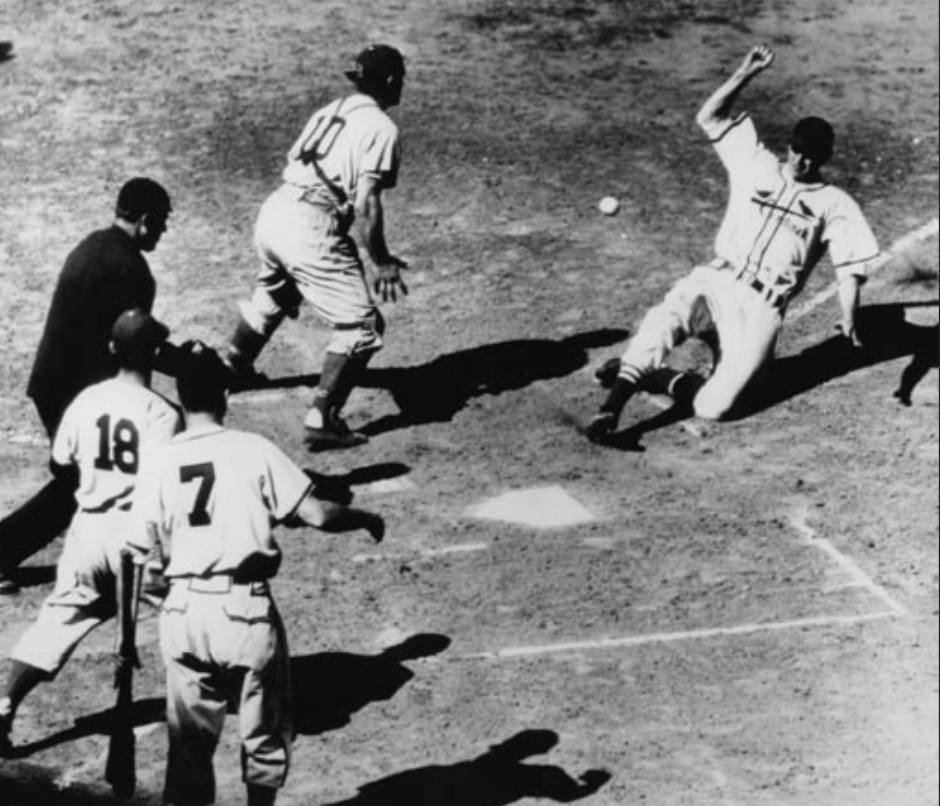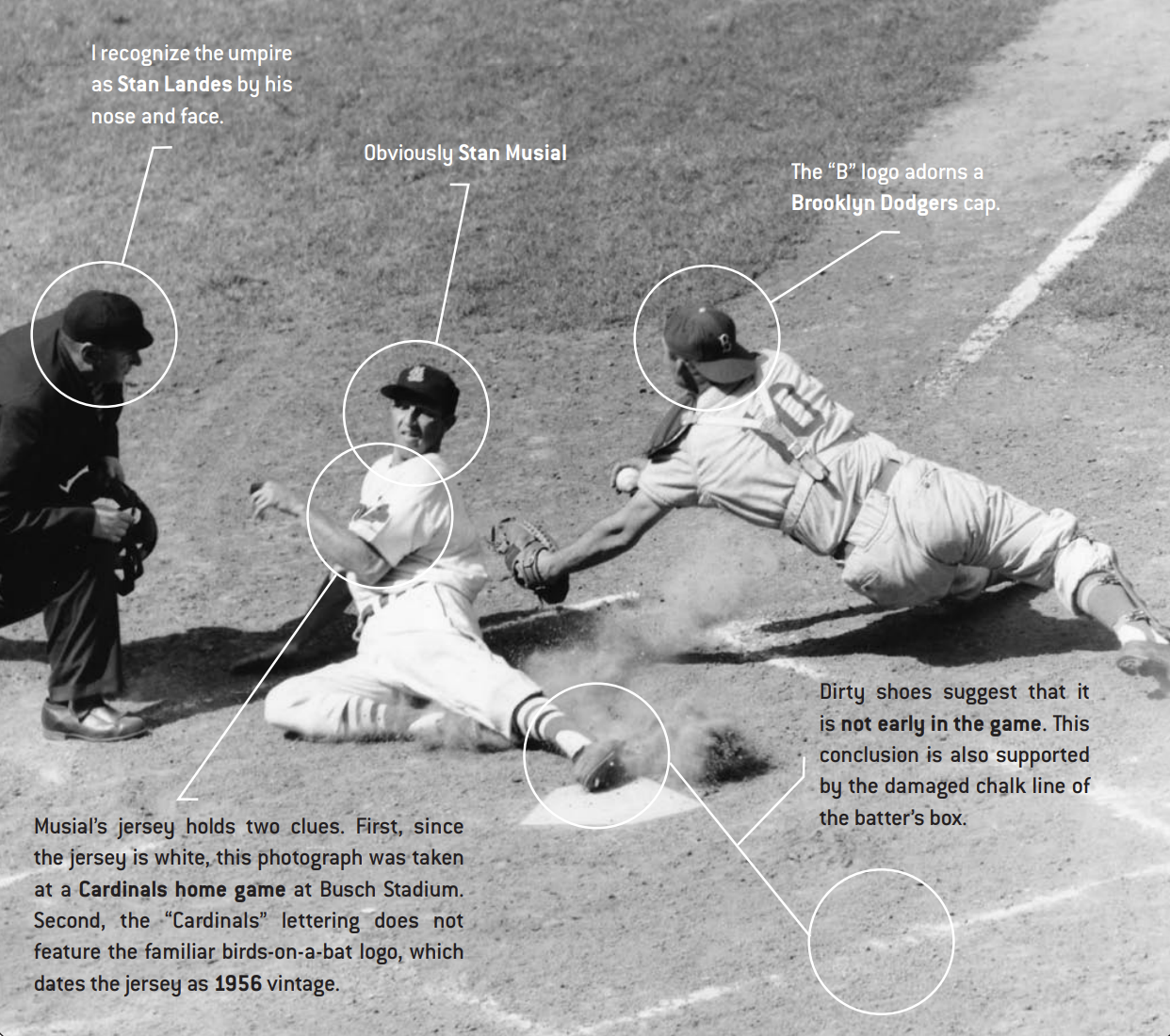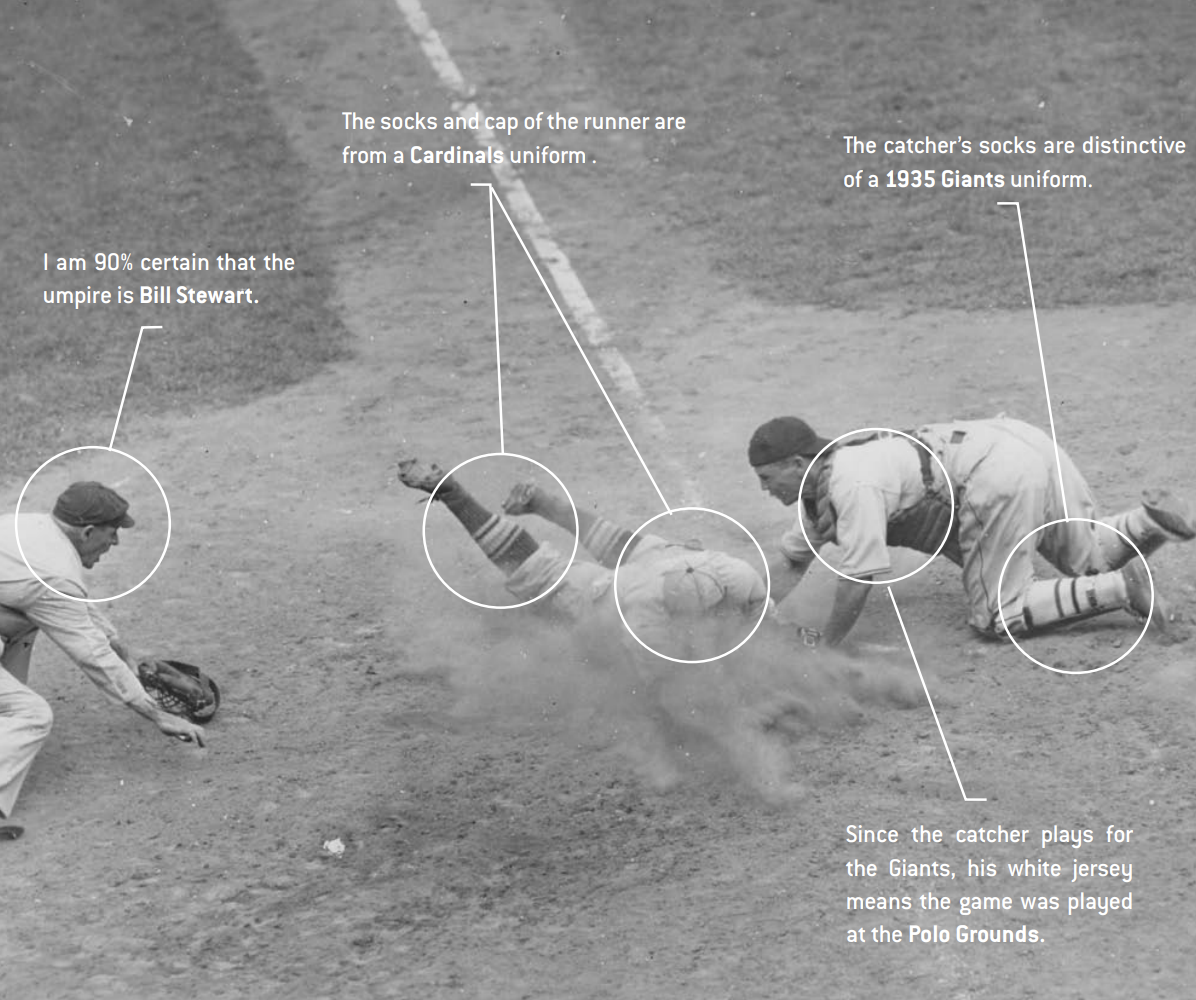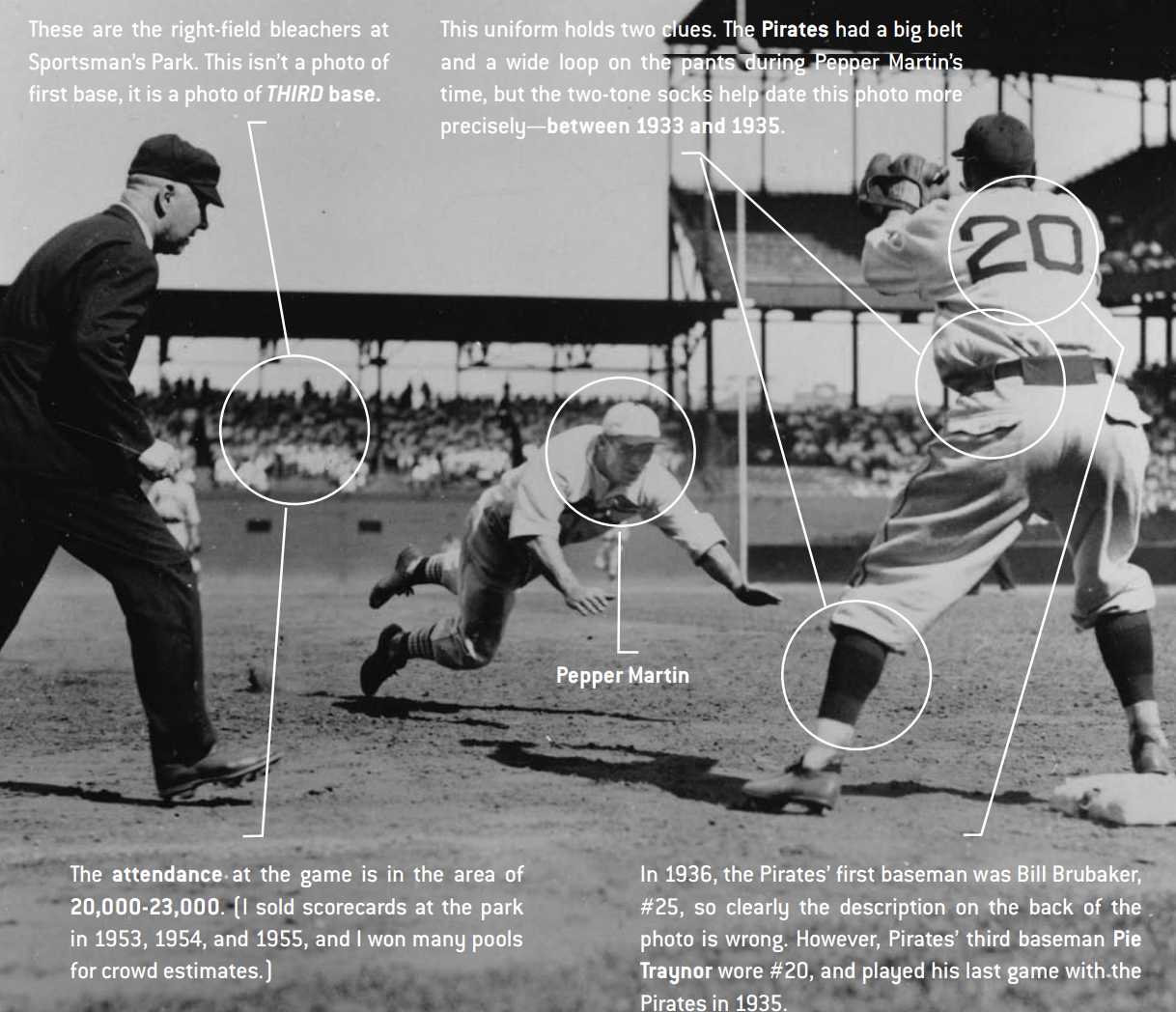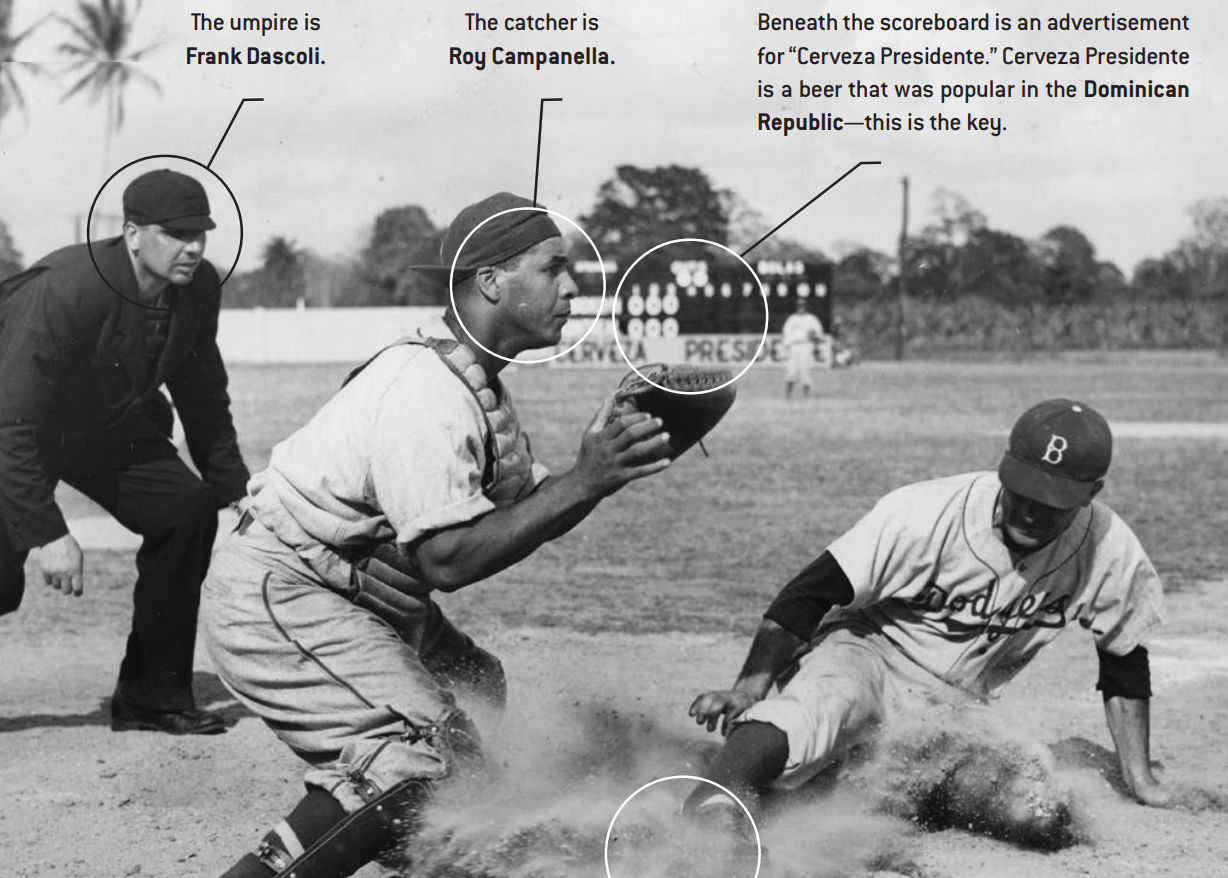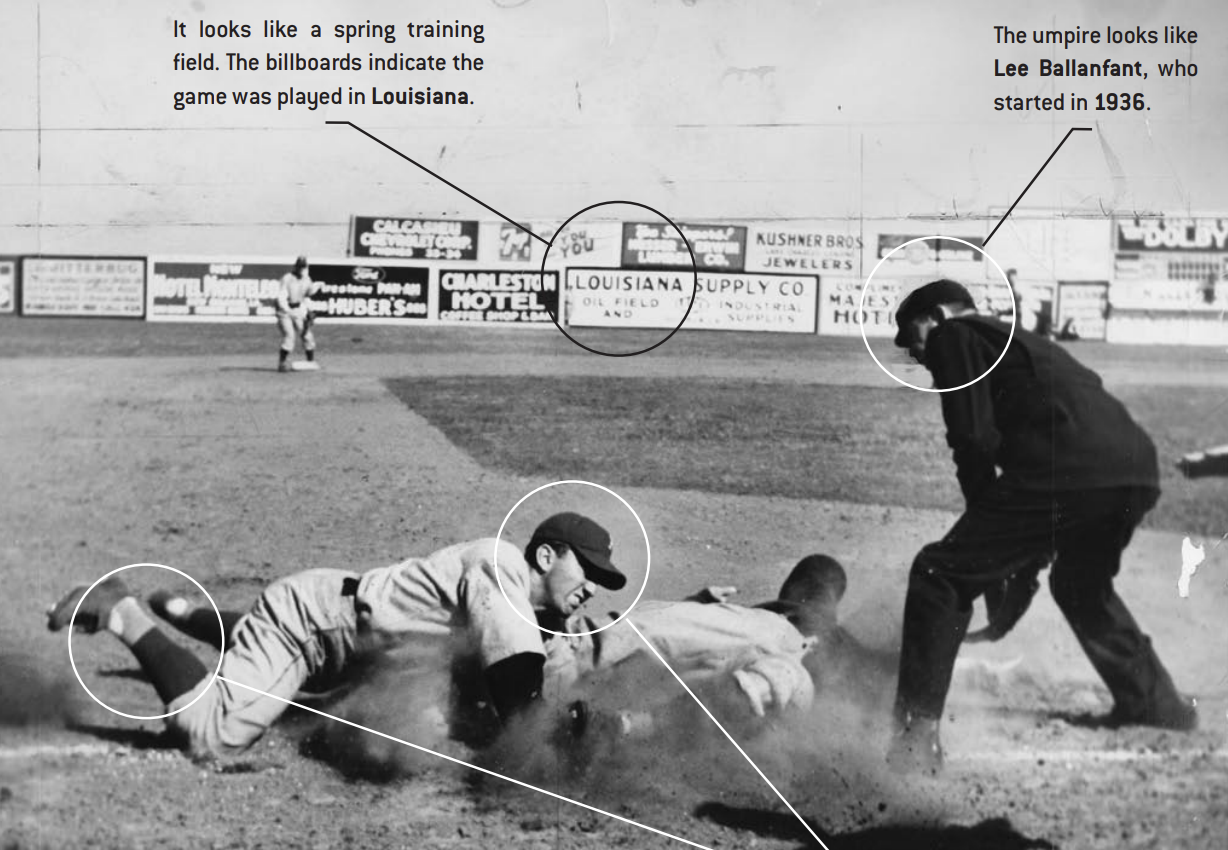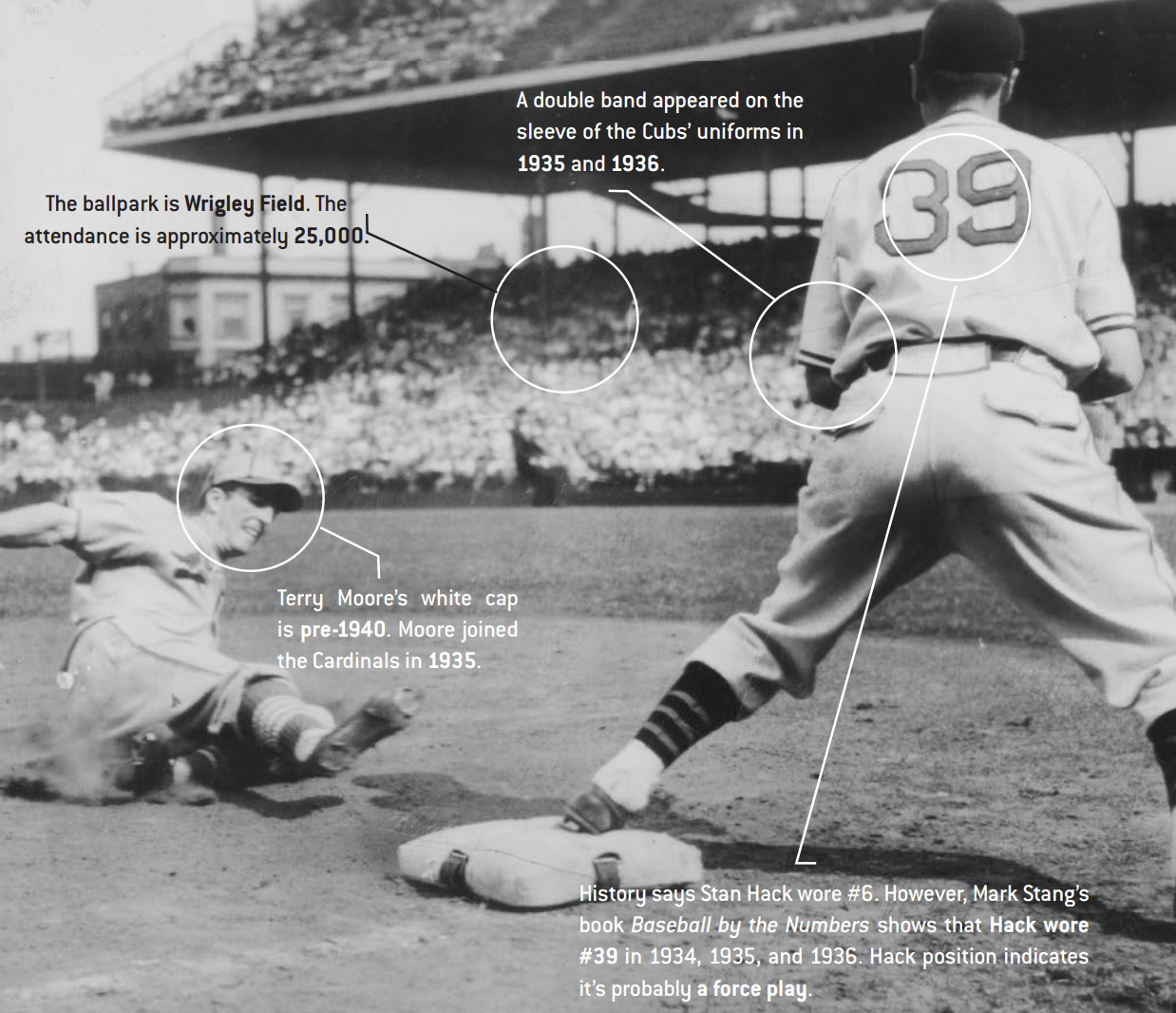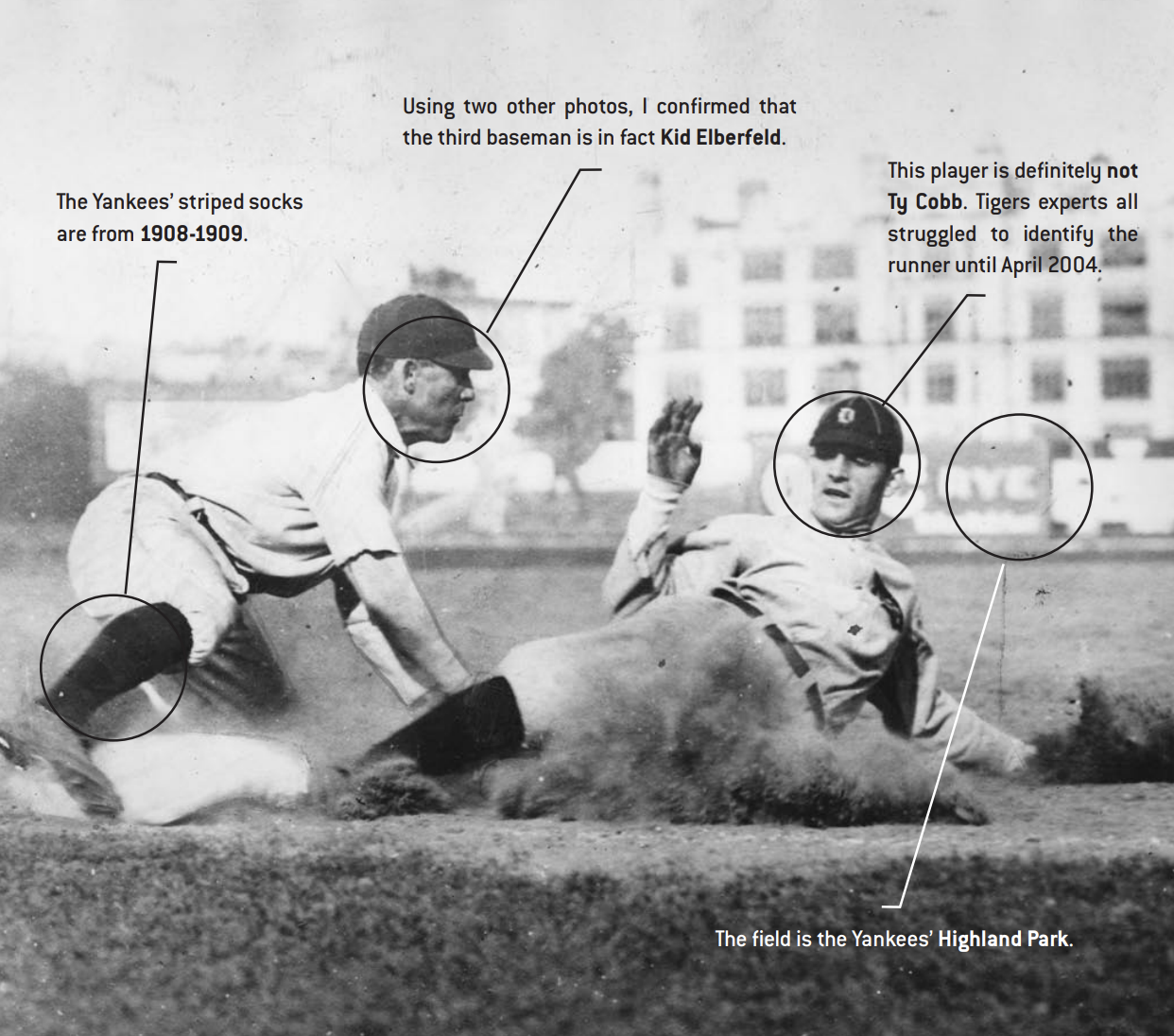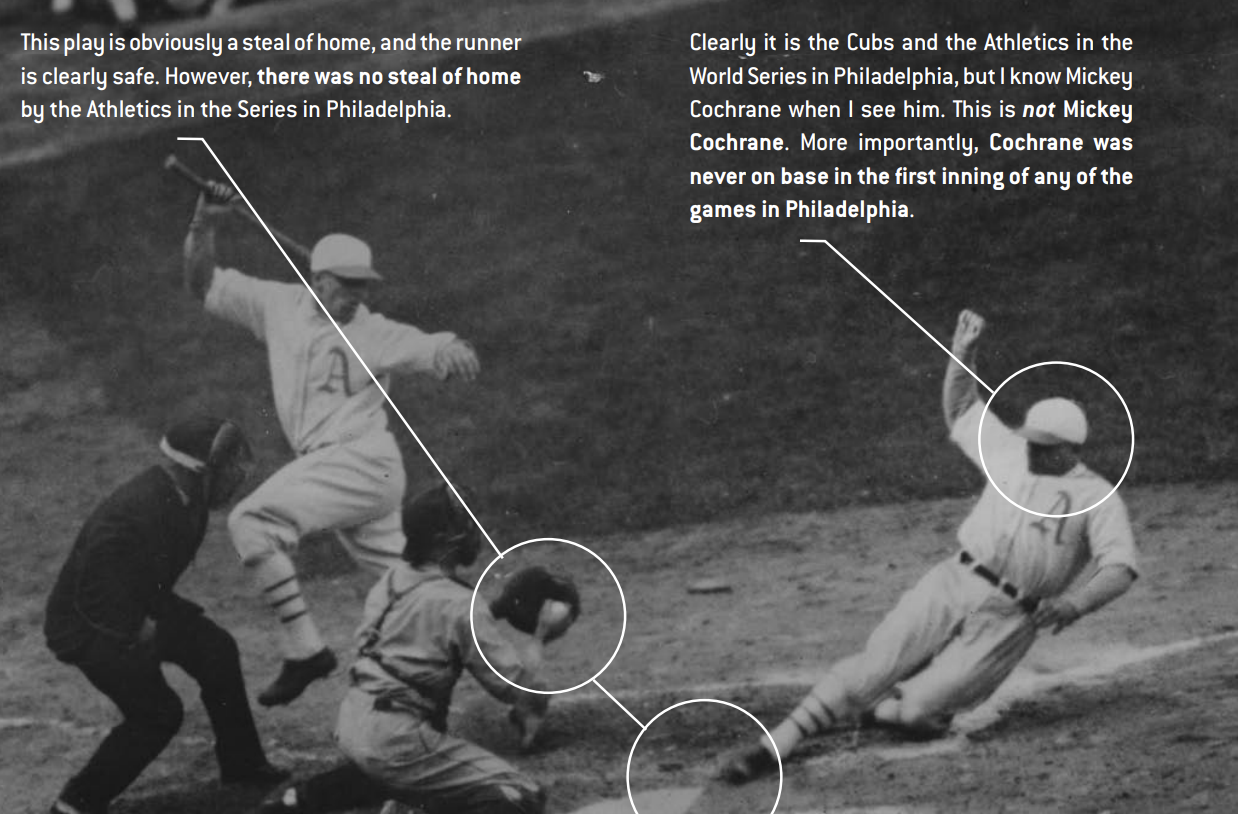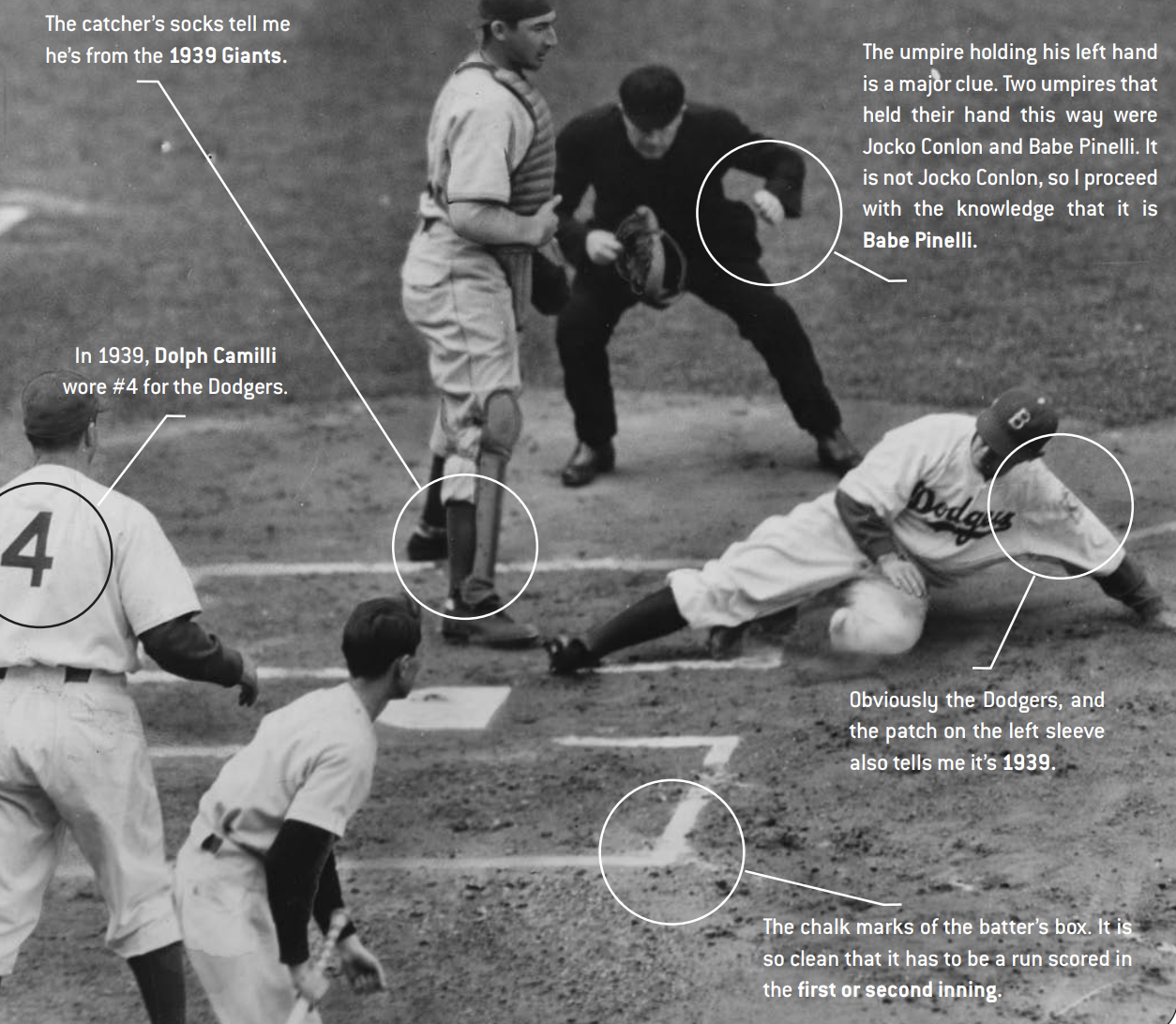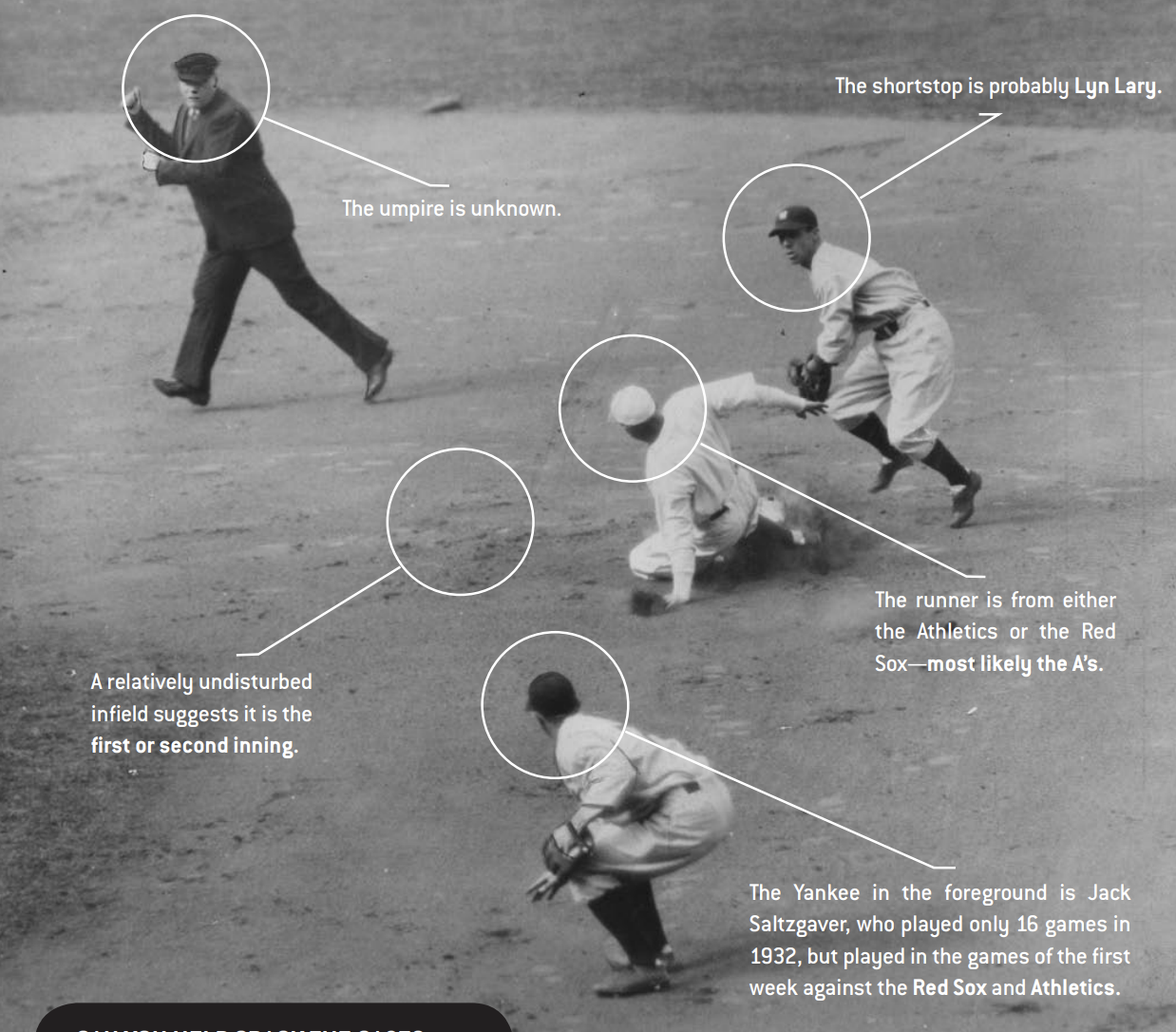Identifying Mystery Photos
This article was written by George Michael
This article was published in 2004 Baseball Research Journal
One day in the late summer of 1947, my mom and I were listening to Harry Caray on the radio describe a very exciting play at the plate during a game between the Cardinals and Dodgers. My mom, who had been clipping sliding action photos from the newspapers for many years, said to me:
“That play might make a good shot for the paper tomorrow.”
The next morning, my mom woke me to show me a photo of the play Harry had described. The photo showed Marty Marion sliding into home plate with the ball bouncing toward Dodger catcher Bruce Edwards.
Now, more than 50 years later, I still consider it to be a perfect sliding photo, and I am still searching for an original print of that very photo. It appeared in the Globe Democrat and was used as an AP wire photo, but I have been unable to find an original of that photo.
Because my mom had been clipping sliding action photos for many years, I was getting an education on baseball photos and how to identify players, teams, and games before I ever attended grade school.
I have spent most of my free time in life in pursuit of all the sliding photos of baseball games from pre-1960 that I can find. This search has resulted in acquiring many photos that over the years have lost their paper captions, which were put on pictures with descriptions of the players in the photographs.
Over the years the effort to identify these photos has led me on some wonderful searches because each photo has its own identity.
For me, the beauty of a photo is in its clarity, the position of the players, and how clear and clean the action is. Stan Musial was far and away the most photogenic slider of all time. Ty Cobb showed more determination, Jackie Robinson was more exciting, but Musial made the picture-perfect slide. Eddie Waitkus and Lou Gehrig also had beautiful sliding techniques, producing great photographs.
In my collection of over 5,000 photos of sliding action, there are some that have presented greater challenges to identify. I will take you on a few detective searches with me to solve these mysteries.
If you are serious about being a photo detective, it is necessary to have certain research tools. It is essential to be able to recognize as many player faces as possible, and it is a major asset to form a file of all major league umpires. Often times an umpire will help determine when the game was played.
As for the research tools, here is what you need: Baseball by the Numbers by Mark Stang, Baseball Uniforms of the 20th Century by Marc Okkonen, Baseball Encyclopedia by Neft & Cohen, and box scores from The Sporting News.
It is also essential that you be willing to spend hours in a library going through newspaper microfiche looking for the actual game story. Following are a few case files on each mystery.
Marty Marion, Cardinal shortstop, starts his slide into home plate with the Cards’ first run of their game with Brooklyn on September 13, 1947. Awaiting the ball is catcher Bruce Edwards. Backing up the play is Brooklyn pitcher Vic Lombardi. Umpire Al Barlick prepares to make the call. This photograph—and all of the photos used in this article—appear courtesy of the George Michael Collection.
Case 1: THE PERFECT SLIDE
This is one of the best examples of the beauty of Stan Musial’s sliding into home. I acquired this photo in 1998, with no identification on the back, from the widow of a photographer for the St. Louis Globe-Democrat. I wanted to know everything there was to know about the photo—the date, the inning, and how the play occurred. Here are the clues I discovered: I recognize the umpire as Stan Landes by his nose and face. Obviously Stan Musial The “B” logo adorns a Brooklyn Dodgers cap.
Musial’s jersey holds two clues. First, since the jersey is white, this photograph was taken at a Cardinals home game at Busch Stadium. Second, the “Cardinals” lettering does not feature the familiar birds-on-a-bat logo, which dates the jersey as 1956 vintage.
Dirty shoes suggest that it is not early in the game. This conclusion is also supported by the damaged chalk line of the batter’s box.
WHAT CRACKED THE CASE
Going through the box scores of Cardinal-Dodger games of 1956 in St. Louis with Rube Walker catching and Stan Landes umpiring leads me to one date: July 21, 1956.
IDENTIFICATION
In the Globe-Democrat, I found this caption under the photo by Bruce Bacon: “In the sixth inning Stan Musial slides away from the tag of Dodger catcher Rube Walker to score the go-ahead run”. Whitey Lockman had grounded to Junior Gilliam, who threw home to Walker. The umpire is Stan Landes. Case closed.
Case 2: A LOT OF DUST
When I first saw this photo, I thought I was in for real trouble. How could I ever identify the player—the runner buried in dust—and no number on the catcher? So I started with the available clues: The socks and cap of the runner are from a Cardinals uniform. The catcher’s socks are distinctive of a 1935 Giants uniform. I am 90% certain that the umpire is Bill Stewart. Since the catcher plays for the Giants, his white jersey means the game was played at the Polo Grounds.
WHAT CRACKED THE CASE
Following my hunch about Bill Stewart, I researched Giants box scores to find that Stewart was indeed the home plate umpire at the Polo Grounds on August 16, 1935.
Pepper Martin oftentimes dove head-first into home. But on August 16, he had only one hit, a home run, which I thought eliminated him from a play at home.
IDENTIFICATION
In the library I found in the Globe-Democrat of August 17, 1935, the photo of: “Pepper Martin diving into home on his inside-the-park home run in the seventh inning as the Giants’ catcher Gus Mancuso reaches for a late tag, umpire Bill Stewart gives Pepper the good news: ‘You are safe.’” Case closed.
Case 3: THE PEPPER MYSTERY
This photo of Pepper Martin was one of the toughest photos I have ever had to identify. The back of the photo, which I got in 1989, says: “‘Pepper Martin sliding into first base, 1936 season at Sportsman’s Park’ — J. Roy Stockton, St. Louis Post-Dispatch.” Well, that’s certainly Pepper Martin. But see what else I divined from this photograph:
These are the right-field bleachers at Sportsman’s Park. This isn’t a photo of first base, it is a photo of THIRD base.
This uniform holds two clues. The Pirates had a big belt and a wide loop on the pants during Pepper Martin’s time, but the two-tone socks help date this photo more precisely—between 1933 and 1935.
The attendance at the game is in the area of 20,000-23,000. (I sold scorecards at the park in 1953, 1954, and 1955, and I won many pools for crowd estimates.)
WHAT CRACKED THE CASE
Checking every Cardinals-Pirates box score from 1933 to 1935 with Martin involved in a play at third base, with a crowd of 20,000- 23,000. On June 12, 1933, the Cardinals and Pirates had a crowd of 21,000, the largest crowd of the year. This is the only date that this play could have occurred.
In 1936, the Pirates’ first baseman was Bill Brubaker, #25, so clearly the description on the back of the photo is wrong. However, Pirates’ third baseman Pie Traynor wore #20, and played his last game with the Pirates in 1935.
IDENTIFICATION
From the play-by-play account of the games of the doubleheader in the June 12, 1933, Pittsburgh Post-Gazette: Eighth inning, first game: “Frankie Frisch singled to right. Martin advanced to third ahead of Paul Waner’s throw to Traynor.”
It took me two years of research to solve this “Mystery of Pepper,” and at long last: Case closed.
Case 4: THE SCOREBOARD
At first glance, this appears to be a photo of a Dodger intra-squad game. Let’s look at the facts:
The umpire is Frank Dascoli.
The catcher is Roy Campanella.
Beneath the scoreboard is an advertisement for “Cerveza Presidente.” Cerveza Presidente is a beer that was popular in the Dominican Republic—this is the key.
WHAT CRACKED THE CASE
In Roy Campanella’s book Great to Be Alive, he writes about playing against the Dodgers in the Dominican Republic in the spring of 1948. Campanella was a catcher for the Montreal Royals that year.
Going through all of the box scores of the Royals and the Dodgers, I looked for a game with the first run scoring in the fourth inning, and that also had Frank Dascoli as the home plate umpire. Such a game took place on March 16, 1948.
The runner is clearly safe on the play, so according to the scoreboard, this must be a photo of the first run of a game.
IDENTIFICATION
From the New York Daily News—3/16/48 game account: “The Dodgers Carl Furillo had an inside-the-park home run in the fourth inning, beating the throw home to Montreal catcher Roy Campanella.” Case closed.
Case 5: THE CHAMBER OF COMMERCE
This is as tough a photo as can be found to identify. At first glance, there is nothing that identifies the players or the teams in this photo. But a close study reveals a few clues:
It looks like a spring training field. The billboards indicate the game was played in Louisiana.
The umpire looks like Lee Ballanfant, who started in 1936.
WHAT CRACKED THE CASE
The Baton Rouge Chamber of Commerce told me none of the companies listed on the billboards still existed. However, they also told me that one of them, the Charleston Hotel, was in Lake Charles, LA. The Lake Charles Chamber of Commerce referred me to McNeese State University, who found that the Giants and the Athletics played at Legion Park in 1939.
Going through the Giants’ spring training games of 1939, I found that the Giants beat the Athletics on March 11, 1939.
The third baseman’s cap appears to have an “A” on it, and his socks resemble those worn by the Athletics of 1936-1940.
IDENTIFICATION
At the Library of Congress, the New York Daily News of March 12, 1939, contained the photo with the caption: “Giants’ Billy Jurgess dashes first-to-third. Athletics’ third baseman Bill Nagel tagged Jurgess out as umpire Lee Ballanfant made the call.”
Thanks to all of the people at the Chamber of Commerce who helped solve this mystery. Case closed.
Case 6: THANKS, MARK STANG
The only thing I know for sure when I first got this picture was that it was Terry Moore of the Cardinals, so here is what I had to work with:The ballpark is Wrigley Field. The attendance is approximately 25,000.
A double band appeared on the sleeve of the Cubs’ uniforms in 1935 and 1936.
Terry Moore’s white cap is pre-1940. Moore joined the Cardinals in 1935. History says Stan Hack wore #6. However, Mark Stang’s book Baseball by the Numbers shows that Hack wore #39 in 1934, 1935, and 1936. Hack position indicates it’s probably a force play.
WHAT CRACKED THE CASE
The photo must be from 1935 or 1936. Going through every game of the Cubs hosting the Cardinals with a crowd of 22,000 to 28,000 leads me to a play-by-play of a game that occurred on August 8, 1936.
IDENTIFICATION
From the St. Louis Globe-Democrat: “In the sixth inning, Pepper Martin laid down a sacrifice bunt which Cubs pitcher Bill Lee fielded and threw to Stan Hack for a force out on Terry Moore at third base.” The Cardinals beat the Cubs 3-2 in 14 innings before a crowd of 25,000. Case closed.
Case 7: THE COBB MYSTERY
I got this photo back in 1994, and the caption on the back reads: “Elberfeld tagging Ty Cobb on a close play at third.” There is also a stamp on the back that says “June 1909.” The only thing I know for sure is that it was taken at a game with the Tigers pre-July 1, 1909.
The Yankees’ striped socks are from 1908-1909.
Using two other photos, I confirmed that the third baseman is in fact Kid Elberfeld.
This player is definitely not Ty Cobb. Tigers experts all struggled to identify the runner until April 2004.
The field is the Yankees’ Highland Park.
WHAT CRACKED THE CASE
Ray Billbrough, longtime SABR member and Tigers fan, gave me the definitive answer: the runner is George Moriarty. Billbrough had the same photo.
IDENTIFICATION
The New York Times story of the June 8 game: “In the second inning, George Moriarty bunted his way on, stole second, and advanced to third on Red Kleinow’s overthrow to second, then beating the outfield throw to Elberfeld at third.”
This photo is a great example of using the knowledge of SABR members. Thanks to 79-year-old Ray Billbrough of Saline, Michigan, a great Tigers fan and researcher, case closed.
Case 8: IT NEVER HAPPENED
This is one of the most frustrating photos I have ever researched. The caption on the back says: “Mickey Cochrane of the Athletics out at home in the first inning of today’s World Series game in Philadelphia.” There is a file date on the photo: “Central Library, December 13, 1929.” So I am sure that it’s from 1929—but let’s see why this photo was so tough:
This play is obviously a steal of home, and the runner is clearly safe. However, there was no steal of home by the Athletics in the Series in Philadelphia.
Clearly it is the Cubs and the Athletics in the World Series in Philadelphia, but I know Mickey Cochrane when I see him. This is not Mickey Cochrane. More importantly, Cochrane was never on base in the first inning of any of the games in Philadelphia.
WHAT CRACKED THE CASE
For more than 12 years I put this photo aside, frustrated that I had seen it in a book, also saying it was Mickey Cochrane.
In early 2004, while on vacation, I used a new SABR research tool called ProQuest and decided to look at the newspapers of October 11 through October 15, 1929, looking for photos that might have been taken early in the game.
The October 13, 1929, Los Angeles Times solved the mystery. It wasn’t the same photo, but one taken from another angle.
IDENTIFICATION
The Times caption read: “Jimmy Dykes would have stolen home in the second inning, but pitcher George Earnshaw was called out on strikes to end the inning.” This is the correct information.
So our misidentified mystery photo was a photo of a play that never happened. Even so, it remains my favorite photo from the 1929 World Series. Case closed.
Case 9: THE HAND
This is the kind of photo that offers a ton of clues, even though I don’t recognize the faces of any of the players.
The catcher’s socks tell me he’s from the 1939 Giants.
The umpire holding his left hand is a major clue. Two umpires that held their hand this way were Jocko Conlon and Babe Pinelli. It is not Jocko Conlon, so I proceed with the knowledge that it is Babe Pinelli.
In 1939, Dolph Camilli wore #4 for the Dodgers. Obviously the Dodgers, and the patch on the left sleeve also tells me it’s 1939. The chalk marks of the batter’s box. It is so clean that it has to be a run scored in the first or second inning.
WHAT CRACKED THE CASE
Although I do not recognize any of the players, I solve the mystery by studying box scores from The Sporting News of 1939.
IDENTIFICATION
I discovered that on April 21, 1939, the Dodgers’ Goody Rosen scored in the first inning on Babe Phelps’ fly ball to Mel Ott, beating the throw home to Giants catcher Harry Danning. Phelps was the batter before Camilli, so I know this is when the play occurred. Babe Pinelli was the home plate umpire on April 21, which confirms the date of the photograph. Case closed.
Case 10: UNSOLVED CASE MYSTERY
While there are always photos that require a great deal of research, some need special help, where research does not provide the answer. Do you have the skill to solve this mystery? I do not know who the runner is in this photograph from a Yankees game in the first week of the 1932 season (the file stamp is dated April 16, 1932). Here are the clues:
The shortstop is probably Lyn Lary.
The umpire is unknown.
A relatively undisturbed infield suggests it is the first or second inning.
The runner is from either the Athletics or the Red Sox—most likely the A’s.
CAN YOU HELP CRACK THE CASE?
The Yankee in the foreground is Jack Saltzgaver, who played only 16 games in 1932, but played in the games of the first week against the Red Sox and Athletics.
Who is the home team? Who is the runner?
IDENTIFICATION
One rule on identifying photos: no guessing! I have to be able to guarantee the accuracy of the research. If you have photos of sliding action, let me hear from you! If you have a pre-1960 mystery, let’s try to solve it!
GEORGE MICHAEL was a nationally known sportscaster, as well as a longtime SABR member and baseball photo collector. He specialized in the analyses of early- to mid-20th century game action scenes (particularly ones that included players sliding), showing remarkable skill in determining the date of the game and even the particular play within the game, along with the identification of the players and umpires present.



